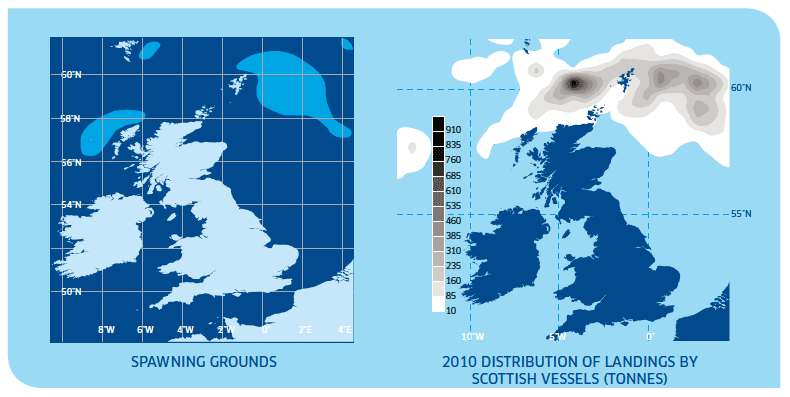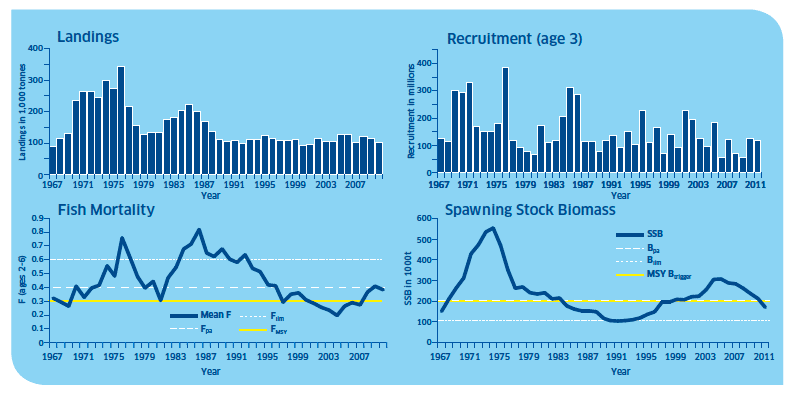Fish and Shellfish Stocks 2012
Fish and Shellfish Stocks 2012. State of Scottish fish stocks, TACs and biology of the stocks for 2012.
SAITHE STOCKS
Saithe ( Pollachius virens) is mainly taken by demersal trawl as part of a directed fishery along the Northern Shelf edge and Norwegian Trench. Saithe are also taken as part of the mixed demersal fishery. They are, by weight, the second most landed roundfish species caught by Scottish fishermen.
2012 position : UK share 9,472 tonnes
Last Year : 10,650 tonnes
Landed into Scotland in 2010 : 13,519 tonnes
Value for 2010 : £12.3 million
Biology
Adult saithe can be caught in almost any sea area but occur mainly around the 200m depth contour. In late summer and autumn young saithe are found in large numbers within Scottish and Norwegian coastal waters, usually on grounds which are unsuitable for commercial fishing. The adult stock can occur in dense shoals which move around the water column and are often caught hundreds of metres above the seabed.
Saithe reach maturity between the ages of four and six years. A medium sized adult female can produce about 2.5 million eggs during a spawning season. Spawning takes place between January and April near to the edge of the continental shelf to the north and west of the Outer Hebrides. Initially the young fish live near to the surface but by mid-summer they can be found close inshore, in bays and harbours. In their second year they live along the shoreline before eventually moving to deeper water. This offshore migration usually occurs in springtime. Saithe grow quickly, averaging around 15cm per year for the first three years and 10cm for the next three, reaching 100cm by the time they are eleven years old.
Saithe are active predators, feeding on the bottom and in mid-water. By weight, fish prey dominate their diet at all times of the year. Herring, Norway pout and sandeel are the main fish species eaten.

ICES ADVICE ON MANAGEMENT
Information Source: ICES advice 2011 ( http://www.ices.dk/committe/acom/comwork/report/2011/2011/sai-3a46.pdf). Quoted text in italics.

MSY and precautionary approach reference points
| Type |
Value |
|
|---|---|---|
| Management Plan |
SSB MP |
200,000 t |
| F MP |
0.3 |
|
| MSY Approach |
MSY B trigger |
200,000 t |
| F msy |
0.3 |
|
| Precautionary Approach |
B lim |
106,000t |
| B pa |
200,000t |
|
| F lim |
0.6 |
|
| F pa |
0.4 |
State of stock and advice
- Fishing mortality, F, has generally increased since 2004 and is currently just below F pa.
- The status of the stock has deteriorated in the last few years. The spawning stock is estimated to have been above B pa from 2001-2008 but has since declined to below B pa.
- Fishing mortality and biomass are both below their precautionary limits. However fishing mortality is above the level which is consistent with achieving maximum sustainable yield ( F 2010< F MSY ).
- This year's advice is in accordance with the EU-Norway management plan, with the 15% TAC constraint imposed, resulting in an advised TAC of 87,550 tonnes in 2012 for the whole assessment area.
There has been a southern shift in geographical distribution in fishing pattern, at least for the German fleet. This is probably due to EU fleets coming under the effort regime of the EU cod management plan, and may shift the distribution of catches toward younger fish. Due to these changes in fishery distribution and stock productivity (lower growth and recruitment) a re-evaluation of the management plan for saithe stocks is needed. The re-evaluation is envisaged for 2012.
Management outcomes for 2012
At the December 2011 meeting in Brussels, the Council of Ministers decided that the international Total Allowable Catch for North Sea and west of Scotland saithe should be 87,550 tonnes. The UK quota for 2012 was set at 9,472 tonnes.
This quota decision was reached in accordance with ICES advice and the saithe long term management plan.
Contact
There is a problem
Thanks for your feedback